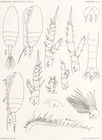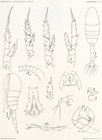RAS taxon details
Racovitzanus antarcticus Giesbrecht, 1902
104784 (urn:lsid:marinespecies.org:taxname:104784)
accepted
Species
marine, brackish, fresh, terrestrial
Giesbrecht, W. (1902). Zoologie Copepoden. <em>In: Résultats du voyage du S.Y. Belgica en 1897-1898-1899. Rapports scientifiques publiés aux frais du Government Belge.</em> :1-49, pls. 1-13. [details] 
Distribution According to Farran (1929) this species would represent an indicator for the deep currents of Antarctic origin.
Distribution According to Farran (1929) this species would represent an indicator for the deep currents of Antarctic origin. [details]
Walter, T.C.; Boxshall, G. (2021). World of Copepods database. Racovitzanus antarcticus Giesbrecht, 1902. Accessed through: RAS (Eds.) (2021) Register of Antarctic Species at: http://ras.biodiversity.aq/aphia.php?p=taxdetails&id=104784 on 2025-09-12
RAS (Eds.) (2025). Register of Antarctic Species. Racovitzanus antarcticus Giesbrecht, 1902. Accessed at: https://ras.biodiversity.aq/aphia.php/www.pfeil-verlag.de/04biol/www.pfeil-verlag.de/04biol/aphia.php?p=taxdetails&id=104784 on 2025-09-12
Date
action
by
original description
Giesbrecht, W. (1902). Zoologie Copepoden. <em>In: Résultats du voyage du S.Y. Belgica en 1897-1898-1899. Rapports scientifiques publiés aux frais du Government Belge.</em> :1-49, pls. 1-13. [details] 
context source (Deepsea) Intergovernmental Oceanographic Commission (IOC) of UNESCO. The Ocean Biogeographic Information System (OBIS), available online at http://www.iobis.org/ [details]
basis of record Boxshall, G. (2001). Copepoda (excl. Harpacticoida), <B><I>in</I></B>: Costello, M.J. <i>et al.</i> (Ed.) (2001). <i>European register of marine species: a check-list of the marine species in Europe and a bibliography of guides to their identification. Collection Patrimoines Naturels,</i> 50: pp. 252-268 (look up in IMIS) [details]
additional source Sedova, N.A. & S.S. Grigoryev. (2011). Morphologic variation of Racovitzanus antarcticus (Copepoda, Scolecithricidae) from waters near Kamchatka. <em>Zoologicheskii Zhurnal.</em> 90(5):532-542.(Russian). [details] Available for editors
additional source Lee, B.D. (1966). Distribution and abundance of pelagic copepods in the Drake Passage and off the coast of Argentina, with special reference to hydrology of these areas. Ph.D. Thesis, Texas A&M University, College Station, Texas, 1-250, pls. 1-56. [details] Available for editors
ecology source Brun, P., M.R. Payne & T. Kiørboe. (2017). A trait database for marine copepods. <em>Earth System Science Data.</em> 9(1):99-113., available online at https://doi.org/10.5194/essd-9-99-2017 [details] Available for editors
context source (Deepsea) Intergovernmental Oceanographic Commission (IOC) of UNESCO. The Ocean Biogeographic Information System (OBIS), available online at http://www.iobis.org/ [details]
basis of record Boxshall, G. (2001). Copepoda (excl. Harpacticoida), <B><I>in</I></B>: Costello, M.J. <i>et al.</i> (Ed.) (2001). <i>European register of marine species: a check-list of the marine species in Europe and a bibliography of guides to their identification. Collection Patrimoines Naturels,</i> 50: pp. 252-268 (look up in IMIS) [details]
additional source Sedova, N.A. & S.S. Grigoryev. (2011). Morphologic variation of Racovitzanus antarcticus (Copepoda, Scolecithricidae) from waters near Kamchatka. <em>Zoologicheskii Zhurnal.</em> 90(5):532-542.(Russian). [details] Available for editors
additional source Lee, B.D. (1966). Distribution and abundance of pelagic copepods in the Drake Passage and off the coast of Argentina, with special reference to hydrology of these areas. Ph.D. Thesis, Texas A&M University, College Station, Texas, 1-250, pls. 1-56. [details] Available for editors
ecology source Brun, P., M.R. Payne & T. Kiørboe. (2017). A trait database for marine copepods. <em>Earth System Science Data.</em> 9(1):99-113., available online at https://doi.org/10.5194/essd-9-99-2017 [details] Available for editors
 Present
Present  Inaccurate
Inaccurate  Introduced: alien
Introduced: alien  Containing type locality
Containing type locality
From regional or thematic species database
Distribution According to Farran (1929) this species would represent an indicator for the deep currents of Antarctic origin. [details]
Marine Planktonic Copepods (Banyuls/OOB/UPMC/CNRS) Note: Including taxonomic identification plates, remarks, geographic distribution, ecological information & reference list
To Barcode of Life (5 barcodes)
To Biodiversity Heritage Library (17 publications)
To European Nucleotide Archive, ENA (Racovitzanus antarcticus)
To GenBank (3 nucleotides; 1 proteins)
To Global Biotic Interactions (GloBI)
To PESI
To USNM Invertebrate Zoology Arthropoda Collection (3 records)
To ITIS
To Barcode of Life (5 barcodes)
To Biodiversity Heritage Library (17 publications)
To European Nucleotide Archive, ENA (Racovitzanus antarcticus)
To GenBank (3 nucleotides; 1 proteins)
To Global Biotic Interactions (GloBI)
To PESI
To USNM Invertebrate Zoology Arthropoda Collection (3 records)
To ITIS

